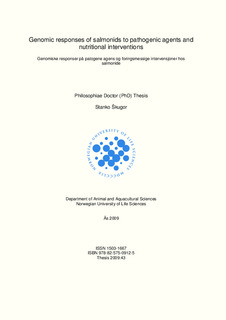| dc.contributor.advisor | Krasnov, Aleksei | |
| dc.contributor.author | Škugor, Stanko | |
| dc.date.accessioned | 2017-02-22T15:15:27Z | |
| dc.date.available | 2017-02-22T15:15:27Z | |
| dc.date.issued | 2009 | |
| dc.identifier.isbn | 978-82-575-0912-5 | |
| dc.identifier.issn | 1503-1667 | |
| dc.identifier.uri | http://hdl.handle.net/11250/2431836 | |
| dc.description.abstract | Aquaculture exposes salmonid fish to diverse stressors, including pathogens and inadequate nutrition. The identification of molecular basis underlying compromised health and growth caused by these factors is confounded by the complexity of induced responses and simultaneous action of multiple stressors. The goal of this thesis was to improve knowledge of several adverse conditions by means of functional genomics. The molecular processes associated with disease resistance and fast growth were investigated with an aid of the salmonid cDNA microarray (SFA.2) enriched with genes involved in stress and immune responses. Genome-wide gene expression profiling was followed with qPCR confirmation of the most important findings. A similar design of experiments was applied. The selection of organs for analyses was based on pilot microarray screening that detected the most informative responses from a wider range of tissue samples. The microarray and qPCR analyses of the transcriptomes revealed the gene expression changes behind the studied phenotypes.
Paper I addressed the molecular determinants underlying high susceptibility to sea lice in Atlantic salmon. Systemic nature of responses and previously unknown role for adaptive immunity were revealed. Alternatively activated macrophages and predominant type 2 differentiation of T helper (Th) cells were observed in response to the parasite. However, this early activation was followed by general immunosuppression in all organs while cellular stress markedly increased in damaged skin. Further, the observed gene expression profile supported the notion of delayed healing of wounds inflicted by sea lice.
Vaccine-dependent determinants of protective responses in Atlantic salmon against the causative agent of furunculosis, Aeromonas salmonicida were investigated in Paper II. The results suggested that tight regulation of the inflammatory response is beneficial for the host. The selective induction of complement components in vaccinated survivors was the only observed enhanced effector immune mechanism. Importantly, elevated expression of genes involved in repair and prevention of immune-mediated damages and in clearance of endogenous and exogenous toxic compounds were associated with survival.
In Paper III, the ability of β-glucan lentinan from shiitake mushroom to modulate inflammation induced by injected lipopolysaccharide (LPS) was tested in rainbow trout. Lentinan dampened the expression of numerous proinflammatory genes in spleen whose activation could have detrimental consequences for the host. Interestingly, cross-experimental comparison revealed remarkable similarities between responses of lentinan fed fish and those observed in salmon resistant to A. salmonicida (Paper II) and infectious salmon anemia virus (ISAV) [1]. Thus, avoiding immunopathology by selective suppression of potentially harmful immune responses was predicted for LPS-challenged trout pre-conditioned with lentinan.
Paper IV examined the effects of three dietary regimens based on: 1) partial fish meal replacement by extracted soybean meal, 2) feeding of control diet at reduced ration and 3) the combination of the interventions, feeding of soybean meal based diet at reduced ration. Highly similar transcriptional responses to soy and reduced feeding were revealed while the joint treatment unexpectedly resulted in weaker expression changes of the majority of hepatic genes. The observed changes in a number of metabolic pathways indicated a high level of conservation of responses to restricted feeding between the cold-blooded and warm-blooded vertebrates. The study identified twelve nutrition-responsive candidate biomarkers but no specific differences between groups. Slower growth could be beneficial for health of salmon due to down-regulation of genes involved in inflammation and stress responses.
The performed studies indicated the regulations of gene expression that can determine the ability of fish cells and tissues to sense and adapt to a wide range of challenges. The identified differentially expressed genes are involved in both generalized and specific responses. Notably, the results illustrate highly contextual nature of biological responses exemplified by inflammation, which is regarded as a “double-edged sword”. Th2-modified response was linked to high susceptibility to sea lice in salmon (Paper I) while fish with excessive inflammatory responses succumbed to furunculosis (Paper II). Results from Paper III were in line with these findings; detrimental consequences from LPS exposure due to overly activated inflammation could be predicted for fish not fed with lentinan. The three studies with pathogenic agents thus illustrate the paramount importance of properly balanced immune responses and their subsequent regulation. Slower growth might be favourable in this sense, as the attenuated gene expression of cellular stress markers and potentially dangerous inflammatory mediators was shown in Paper IV. | nb_NO |
| dc.description.sponsorship | Norges Forskningsråd | nb_NO |
| dc.language.iso | eng | nb_NO |
| dc.publisher | Norwegian University of Life Sciences, Ås | nb_NO |
| dc.relation.ispartofseries | PhD Thesis;2009:43 | |
| dc.rights | Attribution-NonCommercial-NoDerivatives 4.0 Internasjonal | * |
| dc.rights.uri | http://creativecommons.org/licenses/by-nc-nd/4.0/deed.no | * |
| dc.title | Genomic responses of salmonids to pathogenic agents and nutritional interventions | nb_NO |
| dc.title.alternative | Genomiske responser på patogene agens og foringsmessige intervensjoner hos salmonide | nb_NO |
| dc.type | Doctoral thesis | nb_NO |
| dc.subject.nsi | VDP::Agriculture and fishery disciplines: 900::Fisheries science: 920 | nb_NO |
| dc.source.pagenumber | 1 b. (fl. pag.) | nb_NO |

